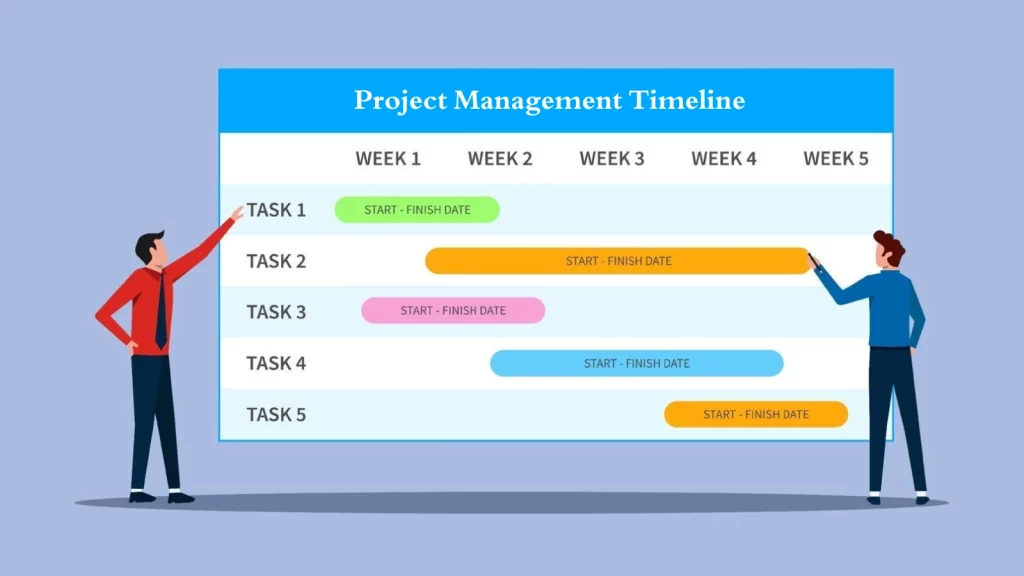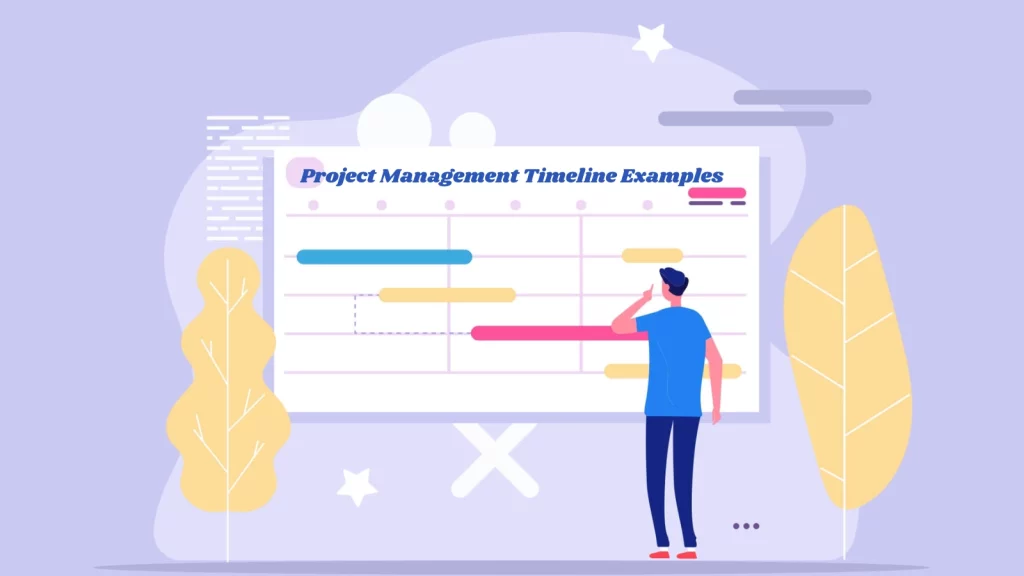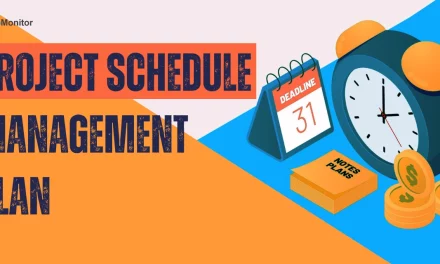With the escalating demand for effective project execution. The need for meticulous project planning has never been greater. At the center of all this planning is the project management timeline. This tool is highly respected by everyone because it helps keep complex projects organized and clear. It makes sure everyone knows what to do when, and who is responsible for what. This makes it easier for teams to work together smoothly, from the beginning of a project to its completion.
These timelines serve as beacons guiding teams through the complex maze of tasks, milestones, and deadlines. They provide a clear roadmap, enabling stakeholders to visualize the journey from project initiation to completion. That is why businesses choose to complete their goals using project deadlines and timelines.
However, this blog is perfect for those looking forward to learning about project management and its timelines. From how to estimate project hours to what are the benefits of management timelines, everything is covered for you.
So, let’s uncover.
In a hurry? Listen to the blog instead!
What Is Project Management Timeline?
A Project Management Timeline, also known as a Project Schedule, serves as a visual roadmap outlining the sequential order of tasks, deadlines, and milestones essential for project execution from start to finish. It encapsulates the entire journey of the project, providing a visual roadmap for successful completion.
The management timeline embodies the essence of project coordination and orchestration. It acts as a blueprint, guiding project teams through the intricacies of their work, while also offering stakeholders a transparent view of project progress and expectations.
For every Project Manager, crafting a Timeline is paramount for effective project and task management. Various practices and tools exist for creating timelines, offering diverse features and functionalities to streamline project tasks. Tools like EmpMonitor helps organizations to create timelines and set deadlines for their project. This practice helps managers to streamline their project management and save them from last minute hustles.
What Are The Types of Project Management Timeline?
In project management, there are four distinct types of timelines, each offering unique advantages and drawbacks. Consider your priorities and requirements before selecting the suitable option for your project.
Gantt Chart Timeline:
A staple in project management, Gantt charts offer a comprehensive project overview showcasing task end dates. These charts highlight key milestones, task dependencies, and task assignees. In today’s tech-savvy environment, Gantt charts are highly interactive and can be updated in real time, ensuring that project progress is always accurately reflected.
Historical Timeline:
A historical timeline presents project tasks in order, akin to traditional history timelines highlighting main events over time. This straightforward format provides a transparent sequence of work.
Team members can easily visualize the progression of activities and milestones, enabling them to identify dependencies, anticipate potential bottlenecks, and track progress against established deadlines. Therefore, it simplifies project tracking and management.
Vertical Chart Timeline:
This project management timeline is best suited for data-centric projects like finance or marketing, vertical charts illustrate progress or gains over a specific timeframe. Whether monitoring monthly website traffic or monthly recurring revenue, these timelines offer a graphical depiction of performance metrics, facilitating informed decision-making.
Kanban Timeline:
A Kanban timeline serves as a visualization tool within a Kanban framework, allowing for the representation of board items on a calendar to facilitate a better grasp of their schedules and interdependencies.
The utilization of a Kanban timeline varies depending on the chosen tool. Some integrate it directly into the Kanban board interface, while others present it as a distinct view capable of aggregating data from multiple Kanban boards.
By understanding the unique features of each timeline type, you can make an informed decision about how to manage and track your project effectively. Moreover, it is also very crucial in lean project management which is the implementation of lean manufacturing principles in project management.
How to Create a Project Management Timeline?
A well-designed timeline ensures your team stays focused and operates efficiently. In the following sections, we have outlined six straightforward steps to create a project deadline, setting your agency up for success.
Step 1: Understand the Project Scope
Before diving into creating a project timeline, it’s essential to grasp the scope of your project. This involves determining the tasks’ duration, overall timeline, and required team members. A well-planned kick off meeting is often crucial to align everyone’s expectations and clarify deliverables.
Step 2: Split the Project into Milestones
List all tasks involved in the project and organize them into milestones. For instance, for a logo design project, milestones could include mock-up designs, color palette research, and client feedback sessions. Break down each milestone into manageable tasks for better planning.
Step 3: Estimate Task Duration
For creating project management timelines break down tasks into smaller parts to estimate their duration accurately. Assign estimated timeframes to each task, considering factors like meetings, research, and design processes. Utilize project management tools with built-in time tracking for enhanced accuracy.
Step 4: Assign Tasks to Your Team
Assign tasks to team members based on their skills and strengths. Match project requirements with individual talents to maximize efficiency. For example, assign logo design tasks to proficient designers and website design tasks to skilled developers.
Step 5: Choose Project Timeline Software
Opt for project schedule management and timeline software like EmpMonitor for seamless tracking and real-time updates. While manual methods like spreadsheets are an option, dedicated software streamlines the process, prevents task overlap, and ensures team-wide visibility.
Step 6: Plot Tasks on the Timeline
Bring the project management timeline to life by plotting each task on the timeline. Consider task dependencies and sequence tasks accordingly. This visual representation aids scheduling and allows team members to manage their time effectively.
Optimize Project Management With EmpMonitor
EmpMonitor is a workforce and project management software designed to help employers track and manage employees’ activities, productivity, and performance while employees work. EmpMonitor has revolutionized projects and team management by giving amazing insights into how employees work and behave.
The intuitive interface and robust features empower managers to monitor and optimize team performance, ensuring projects stay on track and meet deadlines.
The following are the features of EmpMonitor:
-
Project Management Timeline
EmpMonitor includes tools for project management, allowing lead in project management to organize tasks, assign them to team members, and track progress using project management timelines.
This feature ensures that projects stick to their timeline and that everyone knows what they need to do. It also helps people work together better by giving them one place to talk and manage their tasks.
-
Time Tracking
EmpMonitor tracks employee time spent on different tasks throughout the workday. It records when they start and stop working, helping managers understand employees’ time utilization.
Website and Application Monitoring: This feature allows employers to see which websites and applications employees use during work hours. It helps ensure employees focus on work-related tasks and not misuse time on unrelated websites or apps.
-
Keystroke Logging
EmpMonitor can log the keys employees press on their keyboards. While this might sound intrusive, it helps managers understand what tasks are being worked on and completed.
-
Activity Reports
EmpMonitor generates detailed reports based on the data it collects. These reports include information on time spent on different tasks, websites visited, and applications used. They provide valuable insights for managers to assess employee performance and make informed decisions about resource allocation and workflow optimization.
EmpMonitor is a valuable ally for project managers seeking to streamline workflows, enhance productivity, and achieve project management timelines.
How Do You Estimate Time For A Project?
Figuring out how much time a project will take involves thinking about things and planning. Here are steps to estimate time of completion:
- Understand Project Scope: Take the time to understand the project scope. This involves identifying the project’s objectives, constraints (such as budget and deadlines), and other pertinent details. You can determine what you need to accomplish and get clarity by understanding the scope. It helps to set realistic expectations for the timeline.
- Break Down Tasks: Once you get an overview of the project scope, break down the project into smaller, manageable tasks. This step involves creating a detailed list of all the activities required to achieve the project’s objectives. Breaking down tasks ensures that you have covered everything and helps to identify dependencies between different activities for project management timelines.
- Gather Task Data: With the list of tasks in hand, gather data to estimate the time required for each activity. It may involve consulting with team members accountable for completing the tasks, seeking input from subject matter experts, or utilizing historical data from previous projects. Gathering accurate task data is essential for creating realistic estimates.
- Consider Contingencies: Unexpected events or changes can impact the timeline of a project, so it’s essential to plan for them. Allocate contingency hours to check for potential revisions, delays, or unexpected challenges. Contingencies provide a buffer to accommodate changes without derailing the entire project schedule.
- Review and Finalize: Once you have estimated the time for each task and included contingency hours, review the timeline together. Validate assumptions, discuss the estimates with stakeholders, and refine as necessary to ensure the timeline is realistic and achievable. Finalizing the timeline sets clear expectations for all stakeholders and provides a roadmap for successful project execution.
Read More
7 Tips For Better Project Tracking & Deliver Projects On Time
Task And Project Management: Insider Tips For Success
What You Need To Know About Lead In Project Management
Project Management Timelines Examples
Project timelines are beneficial for projects with multiple components. Here are a few specific examples illustrating their advantages:
Example-1: SEO Content Strategy Project Timeline
In the SEO Content Strategy Project Timeline, picture your agency working on crafting a content brief for a new client’s blog. This involves several key tasks: establishing a theme for the blog, creating branding style guidelines, developing a content plan, writing the content, and finally, editing and delivering the final blog post.
In projects like this, where tasks rely on each other (for example, the content plan must be done before writing content), having a well-structured timeline is crucial to avoid delays. To streamline your SEO strategy projects, consider using SEO Planning Templates. Tailored for agencies, these project timeline templates simplify the process from start to finish, ensuring efficient client work.
Example-2 Meeting Timeline Example
Utilizing a project management timeline can significantly enhance productivity and work management, even within the confines of a single meeting. An example of a meeting timeline delineates the agenda, duration, and sequence of topics, furnishing participants with clarity and structure.
The timeline typically commences with an agenda-setting phase, wherein meeting objectives and topics are identified and prioritized based on importance and time constraints. Subsequently, scheduling ensues, determining the meeting date, time, and venue, based on participants’ availability.
Throughout the meeting, the project management timeline serves as a roadmap, assigning specific time slots to each agenda item to prevent overruns and ensure a comprehensive discussion of all topics. Try to implement time management techniques such as timeboxing and prioritization. These techniques aid in maintaining focus and fostering productivity.
The Bottom Line
Project management timelines are evident and these structured schedules are the backbone of successful project execution. With careful planning and implementation, project managers can ensure efficient resource allocation, task prioritization, and timely delivery of project milestones.
Tools like EmpMonitor offer invaluable support, providing real-time insights into team productivity and adherence to project timelines. By leveraging such resources and maintaining clear communication, organizations can optimize their project management processes, enhance team collaboration, and achieve their project goals with confidence and efficiency.














